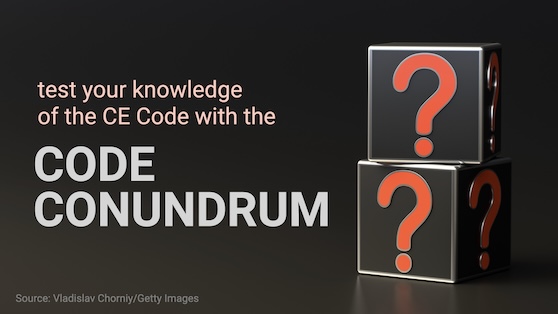
Articles
Features
Articles
Code Conundrum
Codes & Standards
Code Conundrum December 2023
January 2, 2024 | By Ray Yousef
Tackle the code conundrum if you dare!

January 2, 2024 – Welcome to the newest round of questions that test your knowledge of the CE Code-Part I. Answers will appear in the February 2024 edition of Electrical Business Magazine, and online at EBMag.com.
QUESTION 1 – For the identification of intrinsically safe wiring, which of the following methods is acceptable:
a) Cables are labelled
b) Cables are identified Blue
c) Cables are identified Light Blue, where Light Blue is not used for any other cabling
d) a and b
e) a and c
QUESTION 2 – When only 4 conductors of an 8-conductor cable (not marked LP) are used for power, the ampacities obtained from Table 60 must be multiplied by:
a) 0.5
b) 1
c) 1.4
d) 2
e) None of the above
QUESTION 3 – TC-ER cables may transition exposed between cable trays when supported at intervals not exceeding 1.5 m, and mechanically protected by acceptable means or by location.
a) True
b) False
ANSWERS to Code Conundrum, October 2023 edition.
QUESTION 1 – In dwelling units, the CE Code requires no point along the floor line of any usable wall space to be more than ___ horizontally from a receptacle in that space.
a) 1.0 metre
b) 1.2 metres
c) 1.8 metres. Rule 26-722(a).
d) 3.6 metres
QUESTION 2 – The CE Code allows the use of non-metallic sheathed cable in a building of combustible construction.
a) True. Rule 12-504.
b) False
QUESTION 3 – The minimum size conduit (rigid PVC) required to contain six #6 AWG T90 nylon, twelve (12) #14 AWG TWU75, and seven #12 AWG TW75 is:
a) 35 mm
b) 41 mm
c) 53 mm. Rule 12-910.
d) 78 mm
How did you do?
3 • Seasoned journeyman
2 • Need refresher training
1 • Apprentice
0 • Just here for fun!
Ray Yousef is a code engineer with Ontario’s Electrical Safety Authority.

You’ll find all Back Issues of Electrical Business Magazine in our Digital Archive.
Print this page